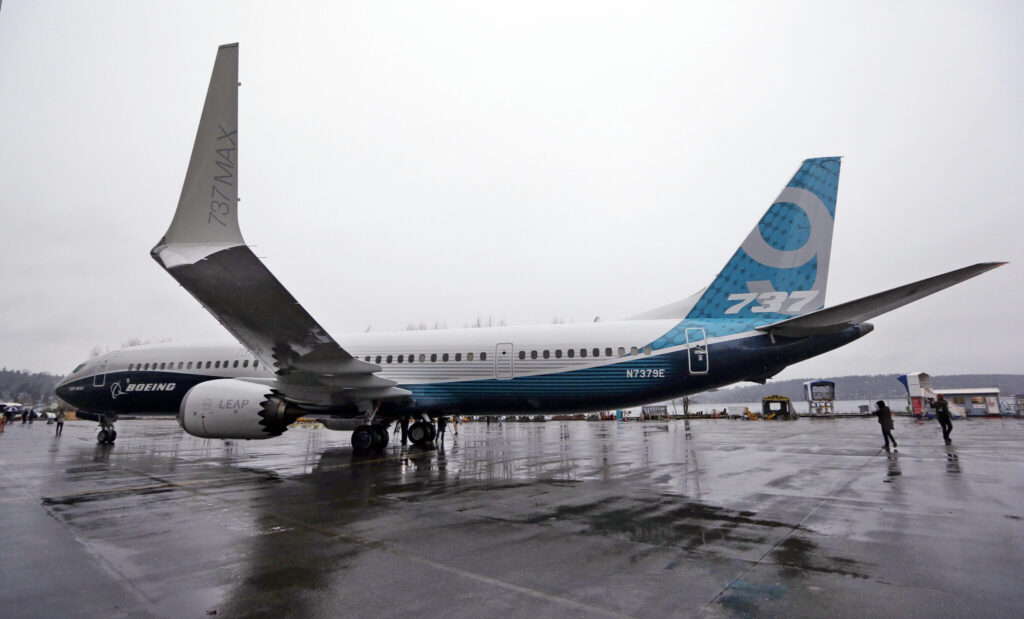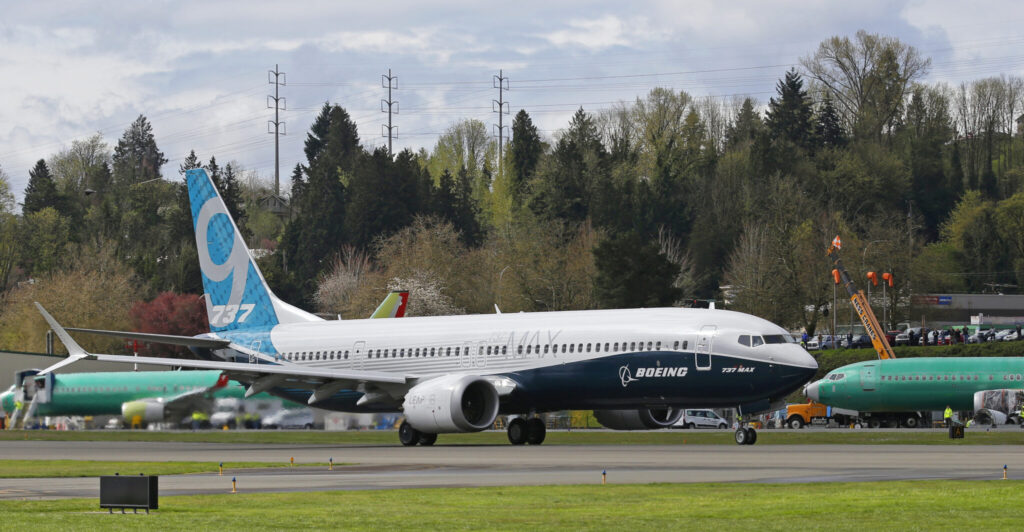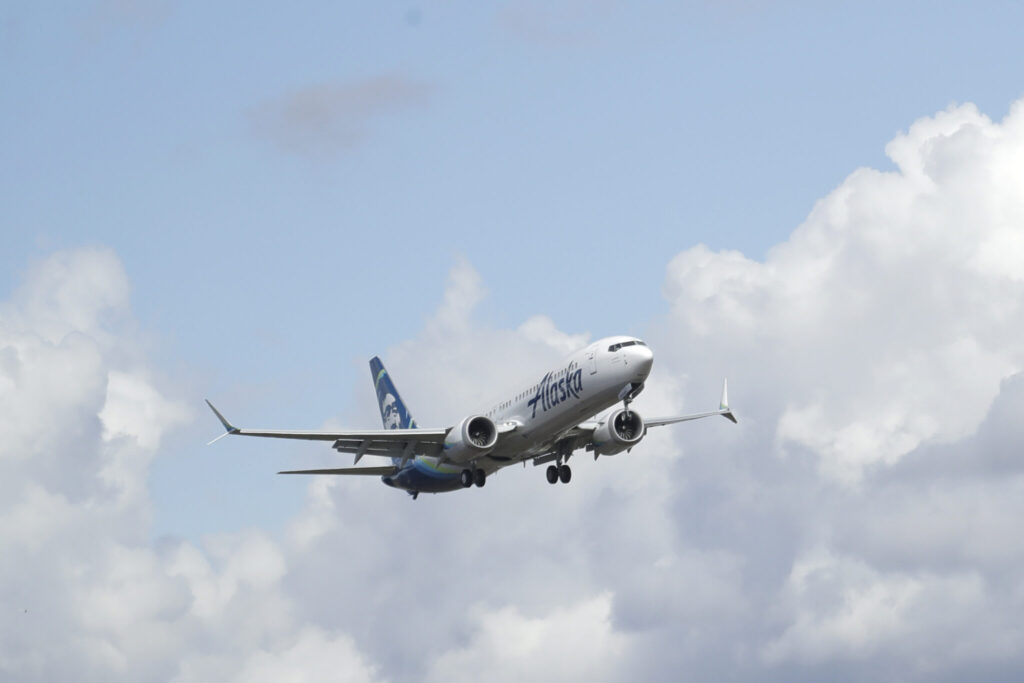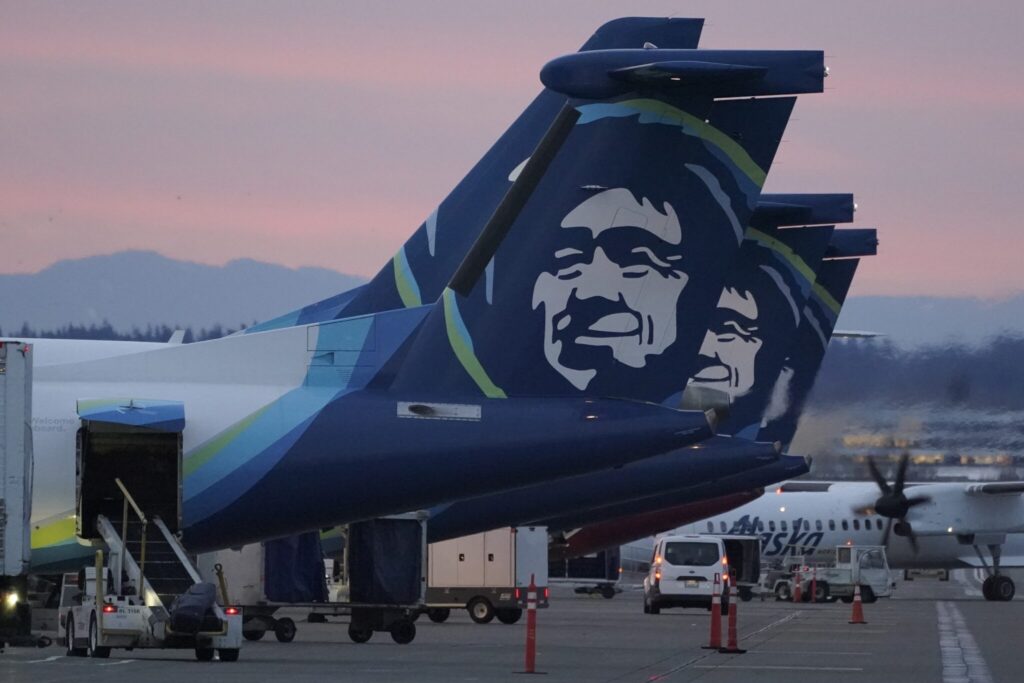Federal officials on Saturday ordered the immediate grounding of Boeing 737 Max 9 jetliners until they are inspected after an Alaska Airlines plane suffered a blowout that left a gaping hole in the side of the fuselage.
Quick Read
- Temporary Grounding of Boeing 737 MAX 9: U.S. regulators have ordered the temporary grounding of 171 Boeing 737 MAX 9 aircraft for safety checks.
- Cabin Panel Incident: The decision follows a cabin panel blowout on an Alaska Airlines flight, which forced an emergency landing.
- FAA’s Immediate Inspections Requirement: The FAA requires immediate inspections of specific Boeing 737 MAX 9 planes before they can return to flight.
- Details of the Incident: The incident involved a piece of fuselage tearing off a jet, which had been in service for just eight weeks, during its flight from Portland to Ontario.
- Impact on Boeing: This new issue adds to Boeing’s challenges, already struggling with safety crises and the pandemic’s impact.
- No Injuries Reported: There were no injuries reported from the structural failure on the Alaska Airlines flight.
- Alaska Airlines’ Response: Alaska Airlines began grounding its Boeing 737 MAX 9 jets and has completed over a quarter of the inspections without finding issues.
- Boeing 737 MAX History: The 737 MAX model was previously grounded for nearly two years following fatal crashes in 2018 and 2019.
- International Reactions: China’s aviation regulator is reportedly considering a response, including a potential new grounding of the Boeing MAX fleet.
- FAA and Boeing’s Actions: The FAA is monitoring inspections, and Boeing is working to gather more information about the incident.
- Details of Flight 1282 Incident: The blowout occurred as the flight reached over 16,000 feet, with passengers experiencing a rapid decompression.
- Production and Design Questions: The incident raises questions about production or design issues, including the use of a “plug” for an optional exit door.
- Government and Industry Response: The NTSB is investigating, and U.S. Transportation Secretary Pete Buttigieg has been briefed on the incident.
- Impact on Airline Operations: The grounding and inspections have caused disruptions, including flight cancellations for Alaska Airlines.
- Safety of Boeing’s 737 MAX Planes: The new incident adds to ongoing safety concerns and scrutiny surrounding Boeing’s 737 MAX planes.
- Immediate Grounding: Federal officials ordered the immediate grounding of Boeing 737 Max 9 aircraft for inspections after an incident involving an Alaska Airlines plane.
- Inspection Duration: The required inspections for each aircraft take approximately four to eight hours and affect about 171 airplanes worldwide.
- Progress of Inspections: Over a quarter of the affected fleet has been inspected as of Saturday morning, with no concerning findings reported.
- Alaska Airlines Incident: An Alaska Airlines jetliner experienced a window and fuselage blowout shortly after takeoff, leading to an emergency landing. The flight carried 174 passengers and six crew members.
- Safety Measures: Passengers and crew donned oxygen masks during the emergency. No serious injuries were reported.
- Investigation: The National Transportation Safety Board announced it will investigate the incident.
- Alaska Airlines Fleet Grounding: Alaska Airlines grounded its 65 Boeing 737 Max 9 aircraft pending inspections.
- Flight Details: The incident occurred on Flight 1282 from Portland to Ontario, California, approximately six minutes after takeoff at an altitude of about 16,000 feet.
- Passenger Experience: Passengers experienced a sudden depressurization and shared videos showing the damage. They applauded when the plane landed safely.
- Aircraft Information: The involved aircraft is new, having entered commercial service in November and flown 145 flights.
- Background of the Boeing 737 Max: The Max is the latest version of Boeing’s 737 and has been frequently used for U.S. domestic flights. It was previously grounded for nearly two years following two fatal crashes involving Max 8 jets.
- FAA Guidelines and Manufacturing Flaws: The FAA had previously issued guidelines limiting the use of anti-ice systems on the Max due to safety concerns. Boeing has also faced interruptions in Max deliveries to address manufacturing flaws.
- Flight Attendants Union’s Commendation: The Association of Flight Attendants commended the crew’s actions during the emergency for ensuring passenger safety.
Reuters has the story:
U.S. temporarily grounds Boeing 737 MAX 9 planes after blowout
Newslooks- Jan 6 (Reuters) –
U.S. regulators have ordered the temporary grounding of 171 Boeing 737 MAX 9 aircraft for safety checks following a cabin panel blowout late Friday that forced a brand-new airplane operated by Alaska Airlines to make an emergency landing.
“The FAA is requiring immediate inspections of certain Boeing 737 MAX 9 planes before they can return to flight,” FAA Administrator Mike Whitaker said on Saturday. “Safety will continue to drive our decision-making as we assist the NTSB’s investigation into Alaska Airlines Flight 1282.”
A piece of fuselage tore off the left side of the jet as it climbed from Portland, Oregon, en route to Ontario, California, forcing pilots to turn back and land safely with 171 passengers and six crew on board. The plane had been in service for just eight weeks.

The Federal Aviation Administration’s decision falls well short of a full indefinite safety ban comparable to the grounding of all MAX-family jets almost five years ago, but deals a new blow to Boeing as it tries to recover from back-to-back crises over safety and the pandemic under massive debts.
Boeing’s best-selling model was grounded for almost two years following crashes in 2018 and 2019. The latest mishap also comes as Boeing and a major supplier are grappling with a succession of production or quality problems.
There were no immediate indications of the cause of the apparent structural failure, nor any reports of injuries.
Alaska Airlines (ALK.N) had already started grounding dozens of the Boeing (BA.N) jets for safety checks.
As of Saturday morning, Alaska said in a statement that it had completed more than a quarter of the inspections and found no issues. It did not respond to a request for further comment.
According to tracking site FlightRadar24, Alaska Airlines had 101 cancellations on Saturday, or 13% of its scheduled flights, though it showed several of the jets were flying.

CEO Ben Minicucci said in a statement its fleet of 65 similar planes would be returned to service only after precautionary maintenance and safety inspections, which he expected to be completed in the “next few days.”
The National Transportation Safety Board said a team of experts in structures, operations and systems would arrive on the scene later on Saturday to begin an investigation.
https://www.newslooks.com/boeing-loses-425m-in-1q-plans-boost-for-max/Boeing said it was working to gather more information and was in contact with the airline.
Flight 1282 had reached just over 16,000 feet when the blowout happened, according to FlightRadar24.
“We’d like to get down,” the pilot told air traffic control, according to a recording posted on liveatc.net.
“We are declaring an emergency. We do need to come down to 10,000,” the pilot added, referring to the initial staging altitude for such emergencies, below which breathing is considered possible for healthy people without extra oxygen.

Social media posts showed oxygen masks deployed and a portion of the aircraft’s side wall missing. Passenger photos appeared to show that a section of the fuselage sometimes used for an optional rear mid-cabin exit door had vanished, leaving a neat door-shaped gap.
The extra door is typically installed by low-cost airlines using extra seats that require more paths for evacuation. However, those doors are permanently “plugged,” or deactivated, on jets with fewer seats, including those of Alaska Airlines.
The plane was delivered to Alaska Airlines in late October and certified in early November, according to FAA data.
Trade publication The Air Current, citing two people familiar with the situation, reported the affected aircraft had twice presented “spurious indications of pressurization issues” on Jan 4, a day before the blowout.
U.S. Transportation Secretary Pete Buttigieg said he had been briefed on the incident and that the FAA is supporting the investigation.
“Grateful to the flight crew that kept passengers safe during this terrifying incident,” he wrote on social media site X, formerly known as Twitter.
PRODUCTION SNAGS
“I can’t imagine what these passengers experienced,” said Anthony Brickhouse, an air safety expert at Embry-Riddle Aeronautical University. “The wind would be rushing through that cabin. It was a probably pretty violent situation, and definitely a scary situation.”
The incident shows the importance of passengers keeping their seatbelts buckled while seated in an airplane even if the fasten seatbelt light is off, Brickhouse said.
The 737 MAX was grounded for 20 months worldwide after two fatal crashes in 2018 and 2019 linked to poorly designed cockpit software killed 346 people in Ethiopia and Indonesia. Boeing is awaiting certification of its smaller MAX 7 and larger MAX 10.
Bloomberg News reported China’s aviation regulator was considering a response to the incident, including a possible new grounding of the Boeing MAX fleet in the country.

China was the first country to ground the MAX in 2019 and has yet to accept new deliveries amid wider U.S. trade tensions, though domestic MAX services resumed in January last year.
Last week, Boeing said it was urging airlines to inspect all 737 MAX airplanes for a possible loose bolt in the rudder control system.
The FAA said it was closely monitoring Boeing 737 MAX inspections and would consider additional action if more loose or missing hardware was found.
The fuselage for Boeing 737 planes, its most popular model, is made by Kansas-based Spirit AeroSystems (SPR.N), which separated from Boeing in 2005.
It was not immediately clear whether the door “plug” used to replace the door when not selected by airlines is also made by Spirit, nor whether the Alaska incident was related to factory processes or design. Spirit referred questions on the Alaska incident to Boeing.
Boeing did not immediately respond to a request for comments on how that part of the jet is assembled.
Federal officials order grounding of Boeing 737 Max 9 jetliners after a plane suffers a blowout
Federal officials on Saturday ordered the immediate grounding of Boeing 737 Max 9 jetliners until they are inspected after an Alaska Airlines plane suffered a blowout that left a gaping hole in the side of the fuselage.
The required inspections take around four to eight hours per aircraft and affect about 171 airplanes worldwide. As of Saturday morning, inspections on more than a quarter of the fleet were complete “with no concerning findings,” the company said.
“Aircraft will return to service as their inspections are completed with our full confidence,” the company said in a statement on X.
An Alaska Airlines jetliner blew out a window and a portion of its fuselage shortly after takeoff 3 miles (4.8 kilometers) above Oregon late Friday, creating a gaping hole that forced the pilots to make an emergency landing as its 174 passengers and six crew members donned oxygen masks.
No one was seriously hurt as the depressurized plane returned safely to Portland International Airport about 20 minutes after it had departed, but the airline grounded its 65 Boeing 737 Max 9 aircraft until they can be inspected. The National Transportation Safety Board said Saturday it will investigate.
Passenger Evan Smith said a boy and his mother were sitting in the row where the window blew out and the child’s shirt was sucked off him and out of the plane.
“You heard a big loud bang to the left rear. A whooshing sound and all the oxygen masks deployed instantly and everyone got those on,” Smith told KATU-TV.
Alaska Airlines CEO Ben Minicucci said the inspection of the company 737-9 fleet aircraft could take days to complete. They make up a fifth of the company’s 314 planes. It wasn’t immediately known Saturday how that would affect the company’s flight schedule.
“We are working with Boeing and regulators to understand what occurred … and will share updates as more information is available,” Minicucci said. “My heart goes out to those who were on this flight – I am so sorry for what you experienced.”
The Port of Portland, which operates the airport, told KPTV that the fire department treated minor injuries at the scene. One person was taken for more treatment, but wasn’t seriously hurt.
Flight 1282 had taken off from Portland at 5:07 p.m. Friday for a two-hour flight to Ontario, California. About six minutes later, the window and a chunk of the fuselage blew out as the plane was at about 16,000 feet (4.8 kilometers). One of the pilots declared an emergency and asked for clearance to descend to 10,000 feet (3 kilometers), the altitude where the air would have enough oxygen to breathe safely.
‘We need to turn back to Portland,” the pilot told controllers in a calm voice that she maintained throughout the landing process.
Videos posted by passengers online showed a gaping hole where the window had been and passengers wearing their masks. They applauded when the plane landed safely about 13 minutes after the window blew out. Firefighters then came down the aisle, asking passengers to remain in their seats as they treated the injured.
The aircraft involved rolled off the assembly line and received its certification just two months ago, according to online FAA records. The plane had been on 145 flights since entering commercial service on Nov. 11, said FlightRadar24, another tracking service. The flight from Portland was the aircraft’s third of the day.
The Max is the newest version of Boeing’s venerable 737, a twin-engine, single-aisle plane frequently used on U.S. domestic flights. The plane went into service in May 2017.
The union representing flight attendants at 19 airlines, including Alaska Airlines, commended the crew for keeping passengers safe.
“Flight Attendants are trained for emergencies and we work every flight for aviation safety first and foremost,” the Association of Flight Attendants said in a statement Saturday.
Two Max 8 jets crashed in 2018 and 2019, killing 346 people and leading to a near two-year worldwide grounding of all Max 8 and Max 9 planes. The planes returned to service only after Boeing made changes to an automated flight control system implicated in the crashes.
Last year, the FAA told pilots to limit use of an anti-ice system on the Max in dry conditions because of concern that inlets around the engines could overheat and break away, possibly striking the plane.
Max deliveries have been interrupted at times to fix manufacturing flaws. The company told airlines in December to inspect the planes for a possible loose bolt in the rudder-control system.






